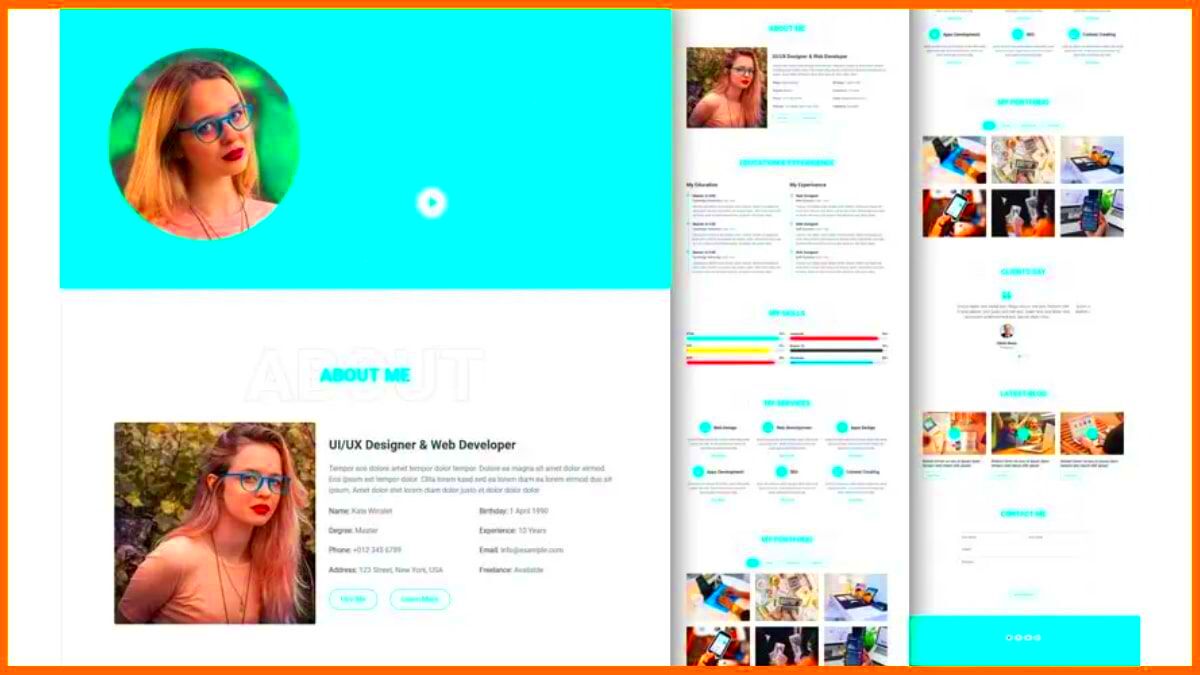When I began my journey as a freelancer I found it challenging to showcase my work effectively. I often heard about the significance of having a solid portfolio but it wasn't until I encountered a few setbacks that I truly understood its importance. Your portfolio goes beyond being a mere compilation of your pieces; it serves as a mirror of your abilities, character and possibilities. It's the impression that many clients will form about you and as the saying goes you only get one opportunity to leave a lasting impression.
Why a Strong Portfolio Matters

Picture this scenario you enter a meeting with a client empty handed no materials to present. It’s akin to arriving at an interview without a copy of your resume. A well crafted portfolio serves a purpose than just displaying your creations; it weaves a narrative about you. It’s an opportunity to highlight your expertise, individuality and the accomplishments you’ve attained. Allow me to explain why this holds significance.
- First Impressions Count: Your portfolio is often the first thing a client sees. A well-crafted portfolio makes you stand out and shows you’re serious about your work.
- Showcases Your Skills: It highlights what you can do and how well you do it. It’s your chance to prove that you’re the right fit for their needs.
- Builds Trust: A strong portfolio builds credibility. It shows potential clients that you have experience and can deliver quality work.
- Reflects Your Style: It’s a platform to showcase your personal style and approach, giving clients a sense of what it’s like to work with you.
Also Read This: Why Did Fiverr Remove Social Media Followers?
Choosing the Right Projects to Showcase
When it comes to selecting projects for your portfolio prioritizing quality over quantity is key. I recall a time when I attempted to showcase every single piece of work I had done. It seemed like I was bombarding potential clients with an overload of details. Here are some tips on choosing projects to feature.
- Highlight Your Best Work: Select projects that best showcase your skills and results. Include work that you’re proud of and that aligns with the type of projects you want to attract.
- Include Varied Examples: Show a range of work to demonstrate versatility. For instance, if you’re a designer, include different types of design work, from logos to websites.
- Show Results: Whenever possible, include examples that highlight the impact of your work. For example, if a design increased engagement for a client, mention it.
- Update Regularly: Keep your portfolio fresh by regularly updating it with new projects. This shows that you’re active and evolving in your field.
Also Read This: Can You Refund on Fiverr? A Comprehensive Guide
Organizing Your Portfolio for Maximum Impact
When I initially assembled my portfolio I believed that simply throwing all my work in one spot would suffice. It was only upon receiving feedback that I came to understand the significance of structure. Picture stepping into a library with books haphazardly strewn about locating the right one would be quite a challenge. In a way a neatly arranged portfolio allows clients to effortlessly browse through and discover what they seek.
Here’s a guide on structuring your portfolio to make the most impression.
- Create Clear Sections: Divide your portfolio into clear sections, such as "Graphic Design," "Web Development," or "Copywriting." This helps clients quickly find the type of work they’re interested in.
- Use a Logical Flow: Arrange your work in a logical order. Start with your most impressive projects or those that best represent your skills. Follow with a diverse range of projects that show your versatility.
- Keep It Simple: Avoid clutter. Use whitespace effectively to make your portfolio easy to read and navigate. Too much information can overwhelm potential clients.
- Include Descriptions: For each project, include a brief description that highlights your role, the skills used, and the outcome. This gives context and makes your work more impactful.
Also Read This: Understanding Focus Keywords on Fiverr: A Guide for Freelancers
Highlighting Your Skills and Expertise
In the early days of my career I tended to concentrate on the projects rather than highlighting my individual contributions. However as time went on I came to realize that it's equally important to showcase my abilities and knowledge. Clients are interested in what unique value you offer, beyond visually appealing images or polished designs.
Here are some tips to showcase your abilities and knowledge in a way.
- Feature Relevant Skills: Tailor your portfolio to showcase skills that are relevant to the type of work you want to attract. For instance, if you specialize in UX design, highlight projects that demonstrate your understanding of user experience.
- Showcase Problem-Solving: Include examples where you solved complex problems or overcame challenges. This shows your ability to think critically and handle difficult situations.
- Highlight Technical Proficiency: If you’re skilled in specific tools or technologies, make sure to showcase them. Mention any advanced techniques or tools you’ve mastered.
- Provide Context: Describe your role in each project clearly. Explain how you contributed to the project's success and what specific skills you used.
Also Read This: Getting Started as a Freelance Videographer
Using Testimonials and Reviews Effectively
Early on I discovered how impactful testimonials and reviews can be. When clients spoke highly of my work it often carried more weight than any self marketing effort on my part. Positive feedback can establish trust and credibility making it smoother for potential clients to opt for your services.
Here are some tips on how to make the most of testimonials and reviews.
- Collect Genuine Feedback: After completing a project, ask clients for feedback. A few words of praise can make a huge difference. Ensure the feedback is specific and relates to the work you did.
- Display Prominently: Place testimonials where they can be easily seen, such as on your homepage or a dedicated "Testimonials" page. The goal is to make sure they’re one of the first things potential clients see.
- Include Details: Whenever possible, include the client’s name, position, and company. This adds credibility and shows that your testimonials come from real, satisfied clients.
- Showcase Reviews with Context: Pair testimonials with examples of the work you did for that client. This provides context and reinforces the positive feedback.
Also Read This: How to Get People to See Your Fiverr Gig
Updating Your Portfolio Regularly
When I first started freelancing I made the error of creating my portfolio and then neglecting it. It took me a couple of months to understand how crucial it is to keep it up to date. Similar to a garden requiring maintenance to remain lively your portfolio should be regularly refreshed to showcase your most recent projects and abilities.
Here’s why it’s important to refresh your portfolio and some tips on how to do it successfully.
- Reflect Your Latest Work: Always include your most recent and best work. Clients want to see what you’re currently capable of, not just what you did a year ago.
- Showcase New Skills: As you learn new techniques or tools, update your portfolio to include projects that showcase these skills. This keeps your portfolio relevant and demonstrates your growth.
- Remove Outdated Projects: If you have projects that no longer represent your current style or quality, consider removing them. This helps keep your portfolio focused on your best work.
- Monitor Trends: Stay updated with industry trends and ensure your portfolio reflects current standards. This can be a key factor in attracting clients who are looking for modern and up-to-date work.
Also Read This: What Do People Buy on Fiverr? A Comprehensive Guide
Promoting Your Portfolio to Potential Clients
Creating an impressive portfolio is just one piece of the puzzle. The true test comes when it comes to showcasing it to potential clients. I discovered this lesson through experience—after putting together what I believed to be the portfolio I found out that simply having it available online wasn't sufficient. It's essential to take steps to promote your portfolio and connect with those who could benefit from your skills.
Here are some ways to showcase your portfolio effectively.
- Leverage Social Media: Share your portfolio on platforms like LinkedIn, Instagram, and Twitter. Tailor your posts to highlight different aspects of your work and engage with your audience.
- Network: Attend industry events, webinars, and local meetups. Share your portfolio with people you meet, and don’t hesitate to ask for referrals or introductions.
- Join Freelance Platforms: Utilize platforms like Fiverr or Upwork to showcase your portfolio. These sites have built-in audiences looking for freelance services.
- Collaborate with Others: Partner with other freelancers or businesses. They might feature your portfolio on their websites or social media, giving you access to their audience.
- Optimize for Search Engines: Ensure your portfolio website is optimized for search engines. Use relevant keywords and meta descriptions to help potential clients find you online.
Also Read This: How to Delete Your Fiverr Business Account
FAQ
Q: How often should I update my portfolio?
It’s wise to assess and refresh your portfolio periodically say every few months. That said you should also make updates whenever you finish noteworthy projects or gain new skills.
Q: What if I don’t have many recent projects to add?
If you don’t have a lot of recent projects to show off concentrate on highlighting your top past work and any new skills or techniques you’ve picked up. Additionally you might want to think about taking on projects or doing some freelance work to enhance your portfolio.
Q: How do I choose which projects to include in my portfolio?
Choose projects that highlight your abilities and knowledge. Include work that matches the kind of projects you wish to attract. Emphasize those that showcase your problem solving skills and ability to deliver outcomes.
Q: Can I use client testimonials in my portfolio?
Absolutely, client testimonials can enhance the trustworthiness of your work. Just remember to seek approval from your clients before featuring their comments and ensure that they are tailored and pertinent to the projects you want to highlight.
Conclusion
Building a freelance portfolio is more than just showing off your work; it’s about sharing your journey and highlighting what makes you special to potential clients. It’s important to organize your projects well update your portfolio regularly and actively promote it as each of these steps contributes to helping you stand out in a competitive market. Keep in mind that your portfolio is a document that evolves over time showcasing your development and expertise. By putting in the effort to keep it up to date and relevant you not demonstrate your skills but also convey to clients that you are dedicated and professional. So continue refining and sharing your portfolio and let it pave the way for new and exciting opportunities.




